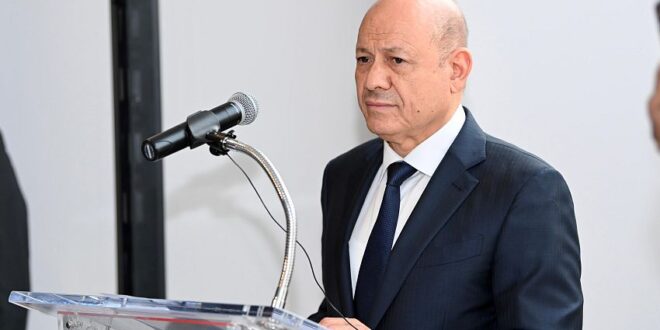New York – Saba
President Dr. Rashad Mohammed Al-Alimi, Chairman of the Presidential Leadership Council, praised the Yemeni-American partnership to protect the ancient Yemeni heritage, which is under threat of plunder as a result of the tragic war conditions sparked by the Houthi militias supported by the Iranian regime.
During the recovery ceremony of two rare Yemeni artifacts at the Metropolitan Museum of Art in New York, President Al-Alimi, on behalf of the Presidential Leadership Council and the government, expressed great thanks and gratitude to the American government and all the cultural, artistic and civil institutions that supported the Yemeni government’s efforts to ban the illegal import and export of cultural property.
In this context, the Chairman of the Presidential Leadership Council noted the US government’s decision to freeze the import of Yemeni antiquities in 2020, leading up to the signing of the agreement to protect Yemeni antiquities last month.
He added, “Today we are witnessing the fruits of the historic agreement between Yemen and the United States on the protection of Yemeni heritage, which was signed last month in Washington, D.C., and established a true partnership on the protection of heritage between our two friendly countries and peoples.”
He continued, “Last year, we witnessed the recovery of 79 ancient artifacts and Qur’anic manuscripts that were seized by the American authorities and handed over to the Yemeni government, and then temporarily deposited in the Smithsonian Museum in Washington. Today, we are recovering two new artifacts and depositing them temporarily here in the Metropolitan Museum until the completion of the process.
“The brutal Houthi coup against the state destroyed and displaced its people, squandered its wealth, and endangered its heritage and identity.”
The Chairman of the Presidential Leadership Council praised the initiative of the Metropolitan Museum of Art to communicate with the Yemeni government in order to recover the Yemeni heritage, which is an inherent right of the ancient Yemeni people.
President Al-Alimi urged the rest of the international museums and artistic institutions, whether in the United States of America or abroad, to follow the example of the “Metropolitan,” and to take the initiative and communicate with Yemeni embassies abroad to return what was looted of Yemeni heritage due to the conditions of war and the destruction caused by the Houthi militia’s coup against the national consensus. .
The President concluded his deliberation by expressing hope that the partnership emerging from the agreement that was signed today between the Yemeni government and the Metropolitan Museum will represent a new road map “to establish a future and an effective partnership between the Yemeni people and international cultural institutions in order to protect Yemeni heritage and raise the level of awareness to limit the continuation of the looting of treasures from our beloved country,” expressing his happiness with the wide participation in this event from those interested in Yemeni affairs, representatives of the American government, and members of the large Yemeni community in the United States.
During the ceremony, Yemen’s Ambassador to the United States, Mohammed Al-Hadrami, and Director of the Metropolitan Museum, signed a cooperation agreement between the two sides that guarantees the recovery of Yemeni artifacts and the continuation of work to protect the ancient cultural and civilizational heritage of the Yemeni people.
The American special envoy, Tim Lenderking, and the director of the Metropolitan Museum, Max Hollen, spoke two welcoming speeches, in which they stressed the importance of the American-Yemeni partnership in the field of combating antiquities smuggling and protecting them, stressing Yemen’s right to obtain the two antiquities dating back to the third millennium BC and the Bronze Age, whenever the government requests this.
The Metropolitan Museum of Art is the largest art museum in the United States, visited on average by more than 5 million people annually, and was the fourth most visited art museum in the world.
 Ministry of Foreign Affairs and Expatriates Official Web Site
Ministry of Foreign Affairs and Expatriates Official Web Site
